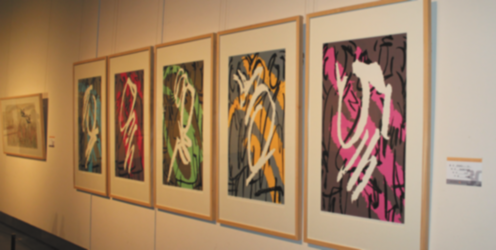 |
|
Works by Zhu Jianhui, president of the Qidong Print Institute. [Photo/provided to China Daily] |
The Qidong Print Institute, China's first institute for print art, recently celebrated its 30th anniversary.
Located in Qidong, Jiangsu province, the institute held an exhibition from June 16 to 21 to mark its 30th birthday. The event was co-organized by the Jiangsu Artists Association, the Communist Party of China Qidong city committee and the Qidong city government.
One hundred artworks by 20 of the institute's artists were displayed at the event. Xu Feng, Party chief of Qidong, said at the opening ceremony that print art has become a name card for Qidong and the city government would further boost the development of woodcut printing by providing support through human resources and finance.
Zhu Jianhui, president of the Qidong Print Institute, said the exhibits were based on real life experiences and enriched with the spirit of the time.
With a history of more than 1,000 years, woodcut printing is an ancient art genre that evolved through the New Woodcut Movement initiated by writer and scholar Lu Xun (1881-1936) in the 1930s.
Although initially trained as a medical doctor, Lu came to believe that the plight of the Chinese masses could be improved only through the widespread dissemination of socially aware art and literature.
Through woodblock prints, Lu saw an effective tool for exposing the social ills of China. Artists influenced by Lu focused on the inequities suffered by the lower classes.
During the War of Resistance Against Japanese Aggression (1937-45), Qidong's local government launched several publications that promoted the art.
In 1959, Muxiehua, or wood shavings, a woodcut print organization comprised of amateur artists, was founded in Qidong, and a collection of the artists' white-and-black works was published. Li Hua (1907-94), a renowned master of woodcut prints, praised the artists’ pioneering spirit and perseverance in pursuing their dreams.
From 1959 to 1985, when the Qidong Print Institute was founded, artists from Muxiehua created more than 2,800 works, among which 34 were displayed at national art exhibitions, 37 were displayed at overseas exhibitions and 48 were collected by art galleries and museums around the country.
The institute has served as a platform for artists to study, create and exchange ideas. The artists' works have also trans- formed from white-and-black prints in the 1950s and 1960s to colored wood block prints and chromatic prints in the 1970s and 1980s.
The institute has eight professional artists, up from five in the early 1990s and only two in 1985.
Since the institute was founded 30 years ago, 98 works from its members have been shown at national art exhibitions and more than 500 have been displayed at provincial art exhibitions.
In addition, nearly 100 works from the institute have been displayed at exhibitions in more than 20 countries and regions, and 118 added to the collections of galleries and museums at home and abroad.
Nine prints from the institute were displayed at the 11th and 12th National Exhibitions of Fine Arts, of which two were nominated for prizes, ranking first among grassroots art institutes in the country.
By Ding Congrong and Huang Hai
For a scholar focusing on Australia's public diplomacy, working as a recreational manager in China may never be part of his career path. But Bradley McConachie does have lots to say now about his special experience at a resort in the picturesque tropical coastal city of Sanya in South China's Hainan province.

One of the potentially most traumatic things a girl has to go through is finding a new hairdresser.